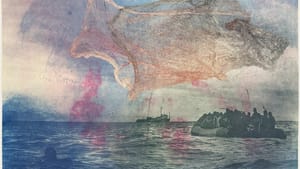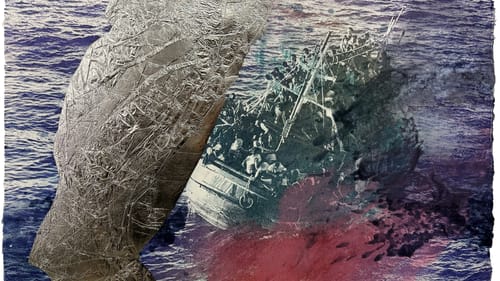Stay in the Loop
BSR publishes on a weekly schedule, with an email newsletter every Wednesday and Thursday morning. There’s no paywall, and subscribing is always free.
Why memories matter
The Print Center presents False Dawn and Memory, Loss

Scenes of desperate people in flight have become inescapable, a seemingly worldwide diaspora driven by war, famine, and persecution. Coverage of the suffering is so heart-wrenching, so unrelenting, that onlookers are overwhelmed. In False Dawn, now at the Print Center, Nazanin Noroozi plunges viewers into the journey of migrants abandoning Africa for southern Europe in a harrowing search for peace and safety.
Noroozi, a New York-based multidisciplinary artist, explores history and memory from personal and collective perspectives. Belonging and displacement are recurring themes. All of these emerge in False Dawn, a 2025 series consisting of a digital film and works on paper.
Though Noroozi was born in Tehran six years after Iran’s 1979 revolution, her family experienced both sides of the event. Their pre-revolutionary photographs and movies are incorporated into False Dawn, along with generic travel images and media coverage of recent migrations.
How migration feels
Noroozi intentionally mars images—painting, scratching, tearing, and otherwise manipulating them—to convey not just how migration looks, but how it feels, transforming witnesses into participants. The fear is palpable in views of an overloaded rubber raft, of looking up to see a wave as tall as a building about to break, and of a far-off boat on the horizon, wondering if it sees your tiny vessel. With these, Noroozi intersperses sunsets, women dancing, a snorkeler slipping into calm water, and a woman on an ocean liner, gazing out at the Statue of Liberty.
Visions of normality and desolation alternate rapidly in the jagged six-and-a-half-minute film. Images shake and fade. The screen splits into three discordant ribbons—small, packed boats ebbing barely above the water line; the back of a rescue boat, about to discharge a lifeline; and a hand, stretching up from the water, finding nothing to grasp.

Blobs of color bloom like jellyfish, expanding across the field of vision like hurled fishing nets to smother the view. Noroozi achieved this effect by applying washes and stains by hand, frame by tedious frame.
The impact of rushing images is heightened by an eerie soundtrack, rising, falling, groaning like a sinking ship, pulsing like a heart under tension, and most ominously, falling silent. Visuals and sound combine to restore the shock of seeing flotillas of humanity for the first time.
A parallel universe
The film exemplifies Noroozi’s technique of compressing time, allowing events to mingle out of sequence, as they do in thought or in memory. “I’m creating this kind of parallel universe where weird things are happening at the same time from the past, present, and future,” Noroozi said in a March 2024 interview with the British Journal of Photography, discussing her series This Bitter Earth.
False Dawn’s eight works on handmade paper are extrapolations from a few base images. To create them, gallery notes indicate, Noroozi incorporated screens of the photographic images into, rather than onto, the wet paper as it was being formed, adding “pieces of colorful paper, open-weave cotton fabric, and emergency reflective silver mylar blankets.” In this way, the paper images not only depict the experience of migrating, they embody it.
The term “false dawn” refers to the natural light preceding sunrise and lingering after sunset. In contemporary usage, the term can refer to an unfulfilled hope. Noroozi uses it to define the transitory space inhabited by migrating people, having departed, but not yet arrived.
Memory, Loss: personal encounters with dementia
Complementing False Dawn in the Print Center’s upstairs galleries is Memory, Loss, an exhibit by seven artists on encounters with dementia. Each has experienced memory loss in a loved one, and their work interprets the impact of memory loss on the individual and those around them.
Philadelphia artist Will Harris’s prints come from his ongoing series You can call me Nana, including Last Breakfast (2018), depicting a woman seated for a meal. The plate and cutlery before her are multiple images, as though this repast is served the same way, on the same dishes, day after day. Behind her, bookshelves with titles like Diabetic Living and Everyday Cooking hint that she once cooked for herself. The most poignant detail, however, is the substitution of a white oval for the woman’s face; she’s no longer inside.
Kaitlin Santoro screen-printed images from a family album on 10 cotton napkins and hung them on lines like laundry. The pictures are faint, like memories on the verge of being forgotten. The diptych Sisters (2025) shows, on the left, a pair of young women. They appear to be in their early 20s, and their hair and dress suggest the 1940s. They lean into one another, smiling and posing for the camera. On the right, time has passed. The sisters’ hair is bobbed, and they stand straight, still close but apart. Each holds a baby in her arms.
Other artists included in Memory, Loss are Janet Biggs, Eloise Hess, Katherine Hubbard, Edra Soto, and Hester Stinnett.
Protecting memories
Memory, Loss and False Dawn consider the fragility of remembering. Whether threatened by illness, inattention, or gaslighting by malign actors who deny what they cannot defend, the exhibits remind us that memories matter and must be protected. And the memories we most want to expunge are as valuable as pleasant ones, maybe more. They may lead to self-examination, understanding, and enable individuals and the world not to repeat the past.
What, When, Where
Nazanin Noroozi: False Dawn and Memory, Loss. Through November 22, 2025, at the Print Center, 1614 Latimer Street, Philadelphia. (215) 735-6090 or printcenter.org.
Accessibility
The Print Center has a small step at the entrance leading to the first-floor gallery and gallery store. The second floor is only accessible by a flight of stairs. For more information, call (215) 735-6090.
Sign up for our newsletter
All of the week's new articles, all in one place. Sign up for the free weekly BSR newsletters, and don't miss a conversation.
